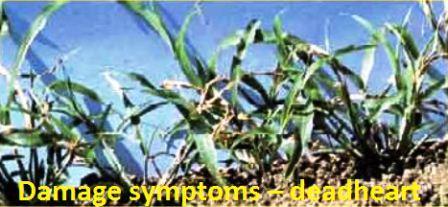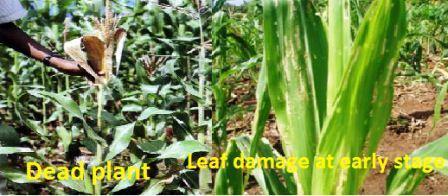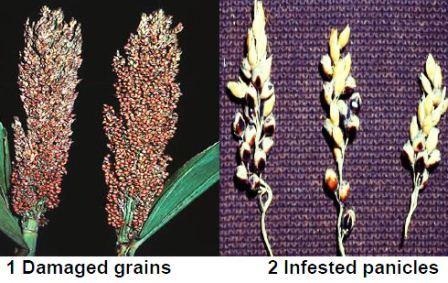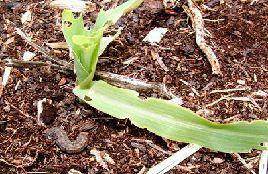Sorghum: Pests Management
Sorghum: Pests Management
Shoot fly
Biology Egg: Eggs are cigarette shape, white coloured laid generally singly parallel to the midrib on the under surface of the 3rd to 5th leaf. Under high shoot-fly pressure, there may be several eggs on the same leaf. Sometimes, as many as 25 eggs may be laid on the same seedling. They hatch in 2-5 days.
Egg: Eggs are cigarette shape, white coloured laid generally singly parallel to the midrib on the under surface of the 3rd to 5th leaf. Under high shoot-fly pressure, there may be several eggs on the same leaf. Sometimes, as many as 25 eggs may be laid on the same seedling. They hatch in 2-5 days.- Maggot: Yellow in colour migrate to the dorsal surface of the leaf, enter the space between the leaf sheath and the axis and make a clean cut at the base of the leaf. The larval period lasts for 6 - 10 days.
- Pupa: Pupation takes place inside the stem and the adults emerge in about a week.
- Adult: The adults are dark brown and similar to domestic housefly, but nearly half the size with the males smaller than the females. The adults usually live for 10 to 20 days.
- The late sown crops generally suffer greater shoot fly damage because of high humidity and moderate temperature.
- Infestation is normally high in the post rainy season crop, which is sown in September- October temperature above 35oC and below 18oC reduces shoot fly survival.
- Damage by at the seedling stage (5 to 30 days after seedling emergence) will lead to the typical dead heart symptoms.
- The larva migrates to the upper side of the leaf, and moves along the leaf whorl until it reaches the growing point where the larvae cut the growing point. As a result the central leaf dries up forming a dead heart, which can be pulled out easily and produces a rotting smell.
- Normally the damage occurs 1 to 4 weeks after seedling emergence. Seedlings of 5 to 30 days old are generally susceptible to shoot fly damage.
- Older plants (>30 days after seedling emergence) are not usually damaged by A. soccata however, under conditions of high humidity during the rainy season, infestation may occur.
- Under these conditions the infested plants do not produce the typical dead heart symptoms. In this instance, the damaged leaf becomes thin and papery, wrapping around the other leaves. The plants may fail to grow normally.
- Late infestations may also damage the panicle in the formative stage, resulting in rotting or drying up of a portion of the panicle affected by shoot fly damage.
- The damage plants produce side tillers
- Infestation is especially high when sorghum planting is staggered due to erractic rainfall.
- Parasitoids : Trichogrammatoidea simmonalsi, Trichogramma chilonis, Neotrichoporoides nyemitawus
- Predators: Spiders, Coccinellids, lace wings etc.
Sorghum stem borer
Biology Egg: The eggs are laid on the underside of a leaf near the midrib in 3-5 rows, in groups of 10-100. They are flattened, oval, and about 0.8 mm long. Hatching takes place after 7-10 days.
Egg: The eggs are laid on the underside of a leaf near the midrib in 3-5 rows, in groups of 10-100. They are flattened, oval, and about 0.8 mm long. Hatching takes place after 7-10 days.- Larva: The young caterpillars produce characteristic leaf windowing. Sometimes the early stages mine in the leaves, causing yellow streaks. After a few days they bore down inside the tunnel. They also may move down outside the stem and then bore into it just above an internode. In older plants the caterpillars sometimes live in the developed heads. In general appearance the larvae look like Busseola fusca larvae (= Maize Stalk Borer). They are creamy pink with groups of dark spots along the back. The head capsule is brown. When mature they are about 25 mm long. The caterpillars can be distinguished from B. fusca and from Sesamia calamistis (= Pink Stalk Borer) by the hooks on its prolegs. In C. partellus these hooks are arranged in a complete circle. In B. fusca and S. calamistis they are arranged in a crescent. The larval period takes 28-35 days.
- Pupa: Pupation takes place in a small chamber in the stem. The pupal period takes 7 10 days.
- Adult: Adult moths have a wingspan of 20-30 mm. Males are smaller and darker than females. The forewings of males are pale brown. The forewings of the females are much paler and the hind wings are almost white.
- Damage occurs as a series of small holes in lines (pin holes) in younger leaves and/or patches of transparent leaf epidermis (window panes) in older leaves.
- Holes in stem caused by larvae tunnelling into the stem can result in broken stems or drying and eventual death of the growing point (deadheart).
- Parasitoid: Cotesia sesamiae, Cotesia chilonis
- Predators: Chrysoperla zastrowi sillemi, ladybird beetle, reduviid bug, spider, fire ant, robber fly, black drongo (King crow), common mynah, big-eyed bug (Geocoris sp), earwig, ground beetle, pentatomid bug (Eocanthecona furcellata), preying mantis, Dicyphus hesperus etc.
Sorghum midge
Biology Eggs: Each white, cylindrical egg, 0.3 by 0.6 mm, is attached to the host spikelet by a slender, tapering stalk.
Eggs: Each white, cylindrical egg, 0.3 by 0.6 mm, is attached to the host spikelet by a slender, tapering stalk.- Maggot: The newly hatched larva is colorless. As it feeds on the developing grain, it gradually becomes pale pink to a deeper pink, then orange, and finally a darker orange or red-orange. The full-grown larva, 1.5 to 2.0 mm long, is slightly flattened and spindle-shaped, tapering to a point at the head.
- Pupa: At first, the pupa is uniformly dark orange, but after a few hours the head, antennae, legs and thorax darken until they become black. Only the abdomen retains the orange color.
- Adult: The sorghum midge is an orange fly, the male measuring approximately 1.3 mm in length and the female 1.6 mm.
- Maggot feed on the developing ovary inside the glumes: this results in empty or chaffy spikelets as shrivelled grains fail to develop.
- During the grain filling or milk stage, if damaged spikelets are pressed between the finger and thumb or between a pair of forceps, they produce a red ooze: the body contents of the midge larva or pupa.
- In the mature crop, damaged spikelets become empty or chaffy, and the sorghum panicles present a blasted appearance.
- Damaged panicles have small, transparent midge pupal cases attached to the tip of the damaged spikelets.
- Parasitoids: Aprostocetus spp.
Cutworm
Biology Egg: The egg is white in color initially, but turns brown with age. It measures 0.43 to 0.50 mm high and 0.51 to 0.58 mm wide and is nearly spherical in shape, with a slightly flattened base. The egg bears 35 to 40 ribs that radiate from the apex; the ribs are alternately long and short. The eggs normally are deposited in clusters on foliage. Females may deposit 1200 to 1900 eggs. Duration of the egg stage is three to six days.
Egg: The egg is white in color initially, but turns brown with age. It measures 0.43 to 0.50 mm high and 0.51 to 0.58 mm wide and is nearly spherical in shape, with a slightly flattened base. The egg bears 35 to 40 ribs that radiate from the apex; the ribs are alternately long and short. The eggs normally are deposited in clusters on foliage. Females may deposit 1200 to 1900 eggs. Duration of the egg stage is three to six days.- Larva: There are five to nine instars, with a total of six to seven instars most common. the larva is rather uniformly colored on the dorsal and lateral surfaces, ranging from light gray or gray-brown to nearly black. The head is brownish with numerous dark spots. Larvae usually remain on the plant until the fourth instar, when they become photo-negative and hide in the soil during the daylight hours. In these latter instars they also tend to sever plants at the soil surface, pulling the plant tissue belowground. Larvae tend to be cannibalistic.
- Pupa: The pupa is 17 to 22 mm long and 5 to 6 mm wide and dark brown. Duration of the pupal stage is normally 12 to 20 days. Pupation occurs belowground at a depth of 3 to 12 cm.
- Adult: The adult is fairly large in size, with a wingspan of 40 to 55 mm. The forewing, especially the proximal two-thirds, is uniformly dark brown. The distal area is marked with a lighter irregular band, and a small but distinct black dash extends distally from the bean-shaped wing spot. The hind wings are whitish to gray, and the veins marked with darker scales.
- Cutworms usually feed at night or during overcast days. Newly hatched larvae feed on weeds, and/or young maize plants if present, leaving small irregular holes in the leaves. Such early feeding is of little significance to plants.
- Larger larvae may completely cut through stalks, which can cause plants to wilt and die. Severe stand reductions can result. They sometimes drag cut plants under soil clods or into small holes in the soil to continue their feeding during the daylight hours.
- In other crops like potatoes and root vegetables, damage can take the form of unsightly holes in the subterranean tubers, which may allow the penetration of secondary fungi.
- When numerous, cutworms can destroy as much as 75% of a crop.
- Parasitoids: Cotesia spp., Meterorus spp., Campoletis spp.
- Predators: Chrysoperla zastrowi sillemi, ladybird beetle, reduviid bug, spider, fire ant, robber fly, black drongo (King crow), common mynah, big-eyed bug (Geocoris sp), earwig, ground beetle, pentatomid bug (Eocanthecona furcellata), preying mantis etc.
White grub
Biology- Egg: A female lays on an average of 27 eggs in the soil, which are pear like white enclosed in earthen cells.
- Grub: Fleshy ‘C’ shaped, whitish yellow in colour found close to the base of the clump.
- Pupa: Pupae are tan to brown, and occur deeper in the soil in earthen chambers.
- Adult: Adult beetles are a rusty-red color just after emerging from the pupal stage, but turn nearly black.
- Yellowing and wilting of leaves.
- Drying of entire crown.
- Affected stem come off easily when pulled.
- Cause extensive damage to roots and base of shoot.
- Parasitoids:Typhia (parasitic wasp)
- Predators: Ground beetle, red ant etc.
IPM for Sorghum
To know the IPM practices for Sorghum, click here.
Source: NIPHM and Directorate of Plant Protection, Quarantine & Storage
Last Modified : 2/13/2020
© C–DAC.All content appearing on the vikaspedia portal is through collaborative effort of vikaspedia and its partners.We encourage you to use and share the content in a respectful and fair manner. Please leave all source links intact and adhere to applicable copyright and intellectual property guidelines and laws.
RELATED ITEMS
Pineapple: Insect and Pest Management
This topic covers the information related to Insec...
Management options for white grub in apple and potato
Topic briefs the Management options for white grub...
Strawberry Insect Pests
This topic covers information about Strawberry In...
Large cardamom: Insect and Pests Management
This topic covers the information related to Insec...
